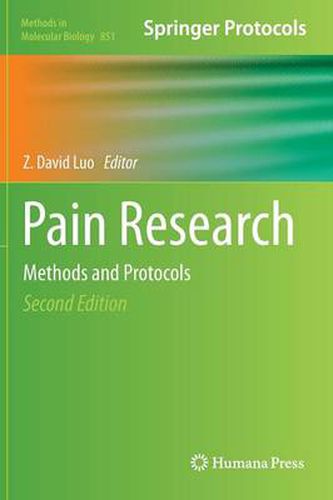Readings Newsletter
Become a Readings Member to make your shopping experience even easier.
Sign in or sign up for free!
You’re not far away from qualifying for FREE standard shipping within Australia
You’ve qualified for FREE standard shipping within Australia
The cart is loading…






This title is printed to order. This book may have been self-published. If so, we cannot guarantee the quality of the content. In the main most books will have gone through the editing process however some may not. We therefore suggest that you be aware of this before ordering this book. If in doubt check either the author or publisher’s details as we are unable to accept any returns unless they are faulty. Please contact us if you have any questions.
The advancements of medical technology, improvements in medical care, and increased patients’ life span make pain research and related drug development high priorities for both the research community and pharmaceutical companies. Rapid development of basic science research tools, such as techniques of flurometric labeling, genomic and proteomic high throughput screening, and genetically modified animals, promotes the swift acceleration of pain research to a stage allowing integrated investigations of pain processing mechanisms at the single cell and/or molecule level, and in a spatially and temporally controlled manner. Using multidisciplinary approaches, we can dissect the complicity of the sensory circuits connecting peripheral stimulation to maladaptive changes in the sensory pathways as well as pain perceptions at the central nervous system. Pain Research: Methods and Protocols, Second Edition provides advanced techniques and animal models that are critical for integrated pain research. Written in the highly successful Methods in Molecular Biology ™ series format, chapters contain introductions to their respective topics, lists of the necessary materials and reagents, step-by-step, readily reproducible laboratory protocols, and notes on troubleshooting and avoiding known pitfalls.
Authoritative and accessible, Pain Research: Methods and Protocols, Second Edition serves as an ideal guide to novice pain researchers who may not have extensive experiences in the field, or to experienced pain researchers who would like to expand their research in new directions and/or to new mechanisms in different models.
$9.00 standard shipping within Australia
FREE standard shipping within Australia for orders over $100.00
Express & International shipping calculated at checkout
This title is printed to order. This book may have been self-published. If so, we cannot guarantee the quality of the content. In the main most books will have gone through the editing process however some may not. We therefore suggest that you be aware of this before ordering this book. If in doubt check either the author or publisher’s details as we are unable to accept any returns unless they are faulty. Please contact us if you have any questions.
The advancements of medical technology, improvements in medical care, and increased patients’ life span make pain research and related drug development high priorities for both the research community and pharmaceutical companies. Rapid development of basic science research tools, such as techniques of flurometric labeling, genomic and proteomic high throughput screening, and genetically modified animals, promotes the swift acceleration of pain research to a stage allowing integrated investigations of pain processing mechanisms at the single cell and/or molecule level, and in a spatially and temporally controlled manner. Using multidisciplinary approaches, we can dissect the complicity of the sensory circuits connecting peripheral stimulation to maladaptive changes in the sensory pathways as well as pain perceptions at the central nervous system. Pain Research: Methods and Protocols, Second Edition provides advanced techniques and animal models that are critical for integrated pain research. Written in the highly successful Methods in Molecular Biology ™ series format, chapters contain introductions to their respective topics, lists of the necessary materials and reagents, step-by-step, readily reproducible laboratory protocols, and notes on troubleshooting and avoiding known pitfalls.
Authoritative and accessible, Pain Research: Methods and Protocols, Second Edition serves as an ideal guide to novice pain researchers who may not have extensive experiences in the field, or to experienced pain researchers who would like to expand their research in new directions and/or to new mechanisms in different models.